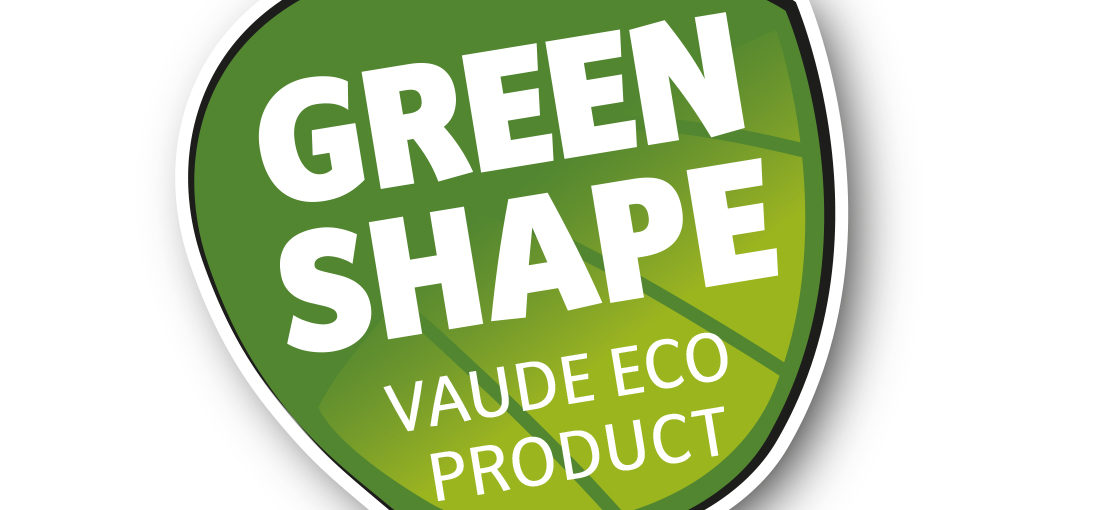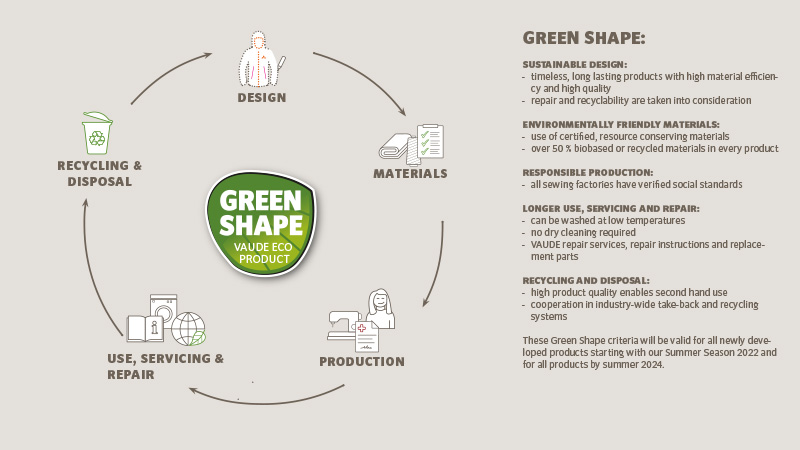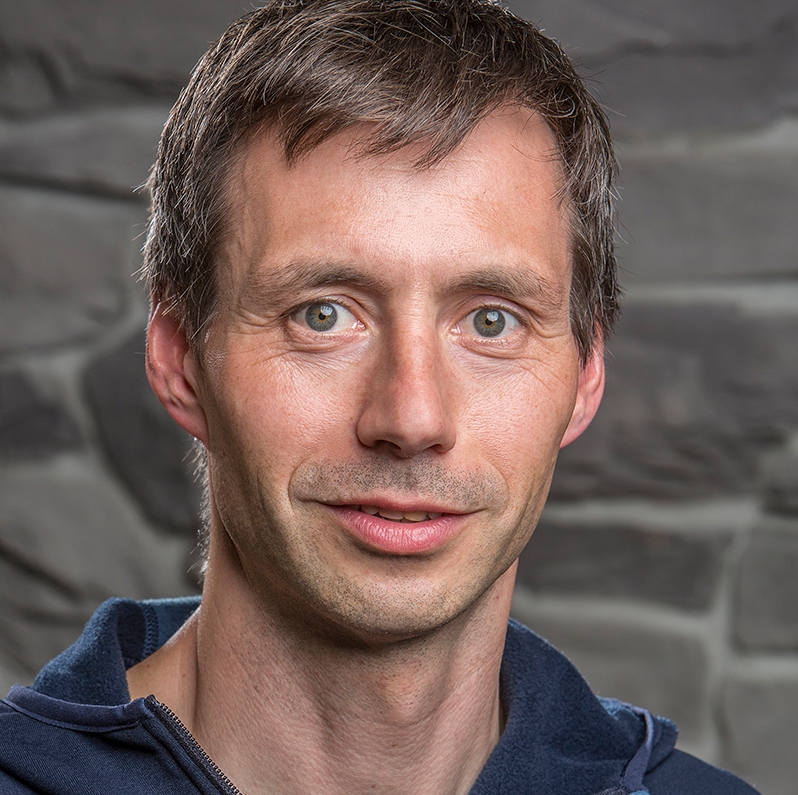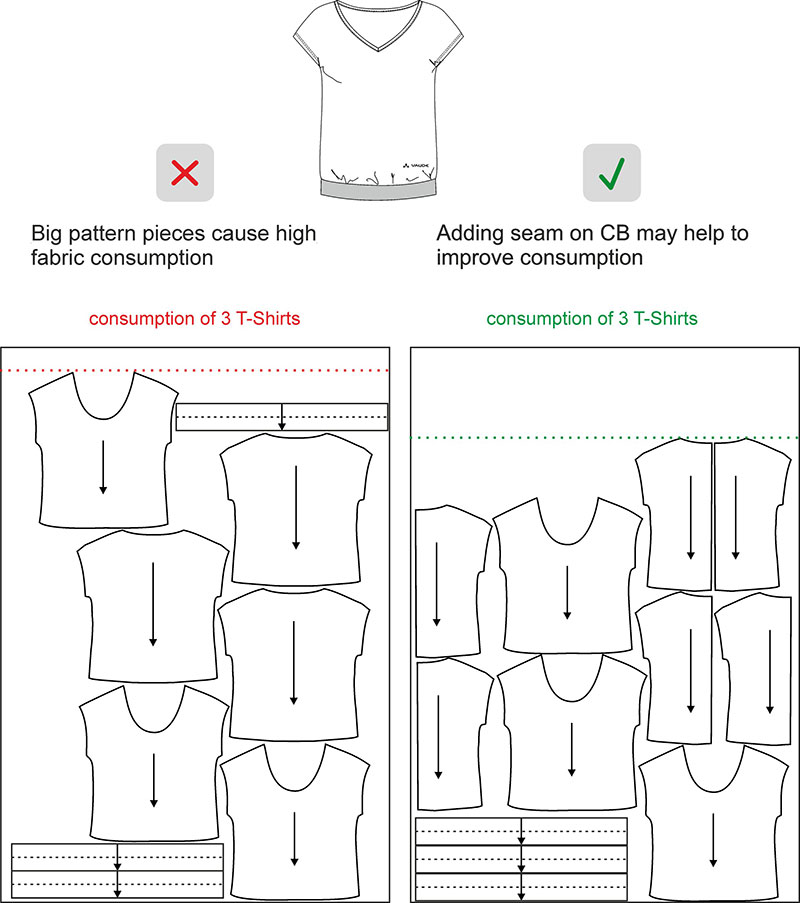
VAUDE Green Shape
VAUDE Eco Collection
Our Green Shape label offers functional, environmentally friendly products made from sustainable materials. We are vigilant about fair working conditions throughout the supply chain.
Our criteria for evaluation are stringent and transparent. They are updated regularly and cover the entire lifecycle of the product from design and production to maintenance, repair and disposal.
Strict criteria for your environmentally-friendly products
How do you assess whether a material, process or product is environmentally friendly? Especially when there is no worldwide standard or comprehensive assessment system, and no certification, let alone something that would be acceptable internationally for all product groups?

Green Shape: sustainable throughout the entire product lifecycle
VAUDE is a pioneer in this field and has developed its own rating system for environmentally friendly outdoor products: Green Shape.
We use the VAUDE Green Shape criteria to evaluate our products with regard to their environmental friendliness.
Watch this short film explaining what Green Shape is about.
Sustainability throughout the entire product life cycle
Green Shape covers the entire product lifecycle with its strict standards – from design and production to maintenance, repair and disposal.
This means that not only the primary materials but also all production sites have to meet the high ecological standards for VAUDE Green Shape products.
In addition, all other components such as buttons, zips and prints must meet the stringent Green Shape criteria.
Aren't there enough eco labels as it is?
Who can understand all these labels anyway…? You might be right. So why does VAUDE have its own label?
In 2009, when we began to steadily steer our product development toward sustainability, awareness for the ecological and social aspects of clothing was only just beginning to develop.
The message was, that we should not only produce "better" (more environmentally friendly) products – customers should also be able to identify them as such in stores.
We searched high and low, but couldn’t find a quality seal that applied to our product groups and our products (which are primarily made from synthetic fibers), and that could be used internationally.
This is why we developed the VAUDE Green Shape concept. VAUDE products that meet the Green Shape criteria are awarded the Green Shape Label. Green Shape has been around since 2010, and it has become very well-established in the market. These days it’s not just recognized by customers our like ourselves; more and more retailers are buying Green Shape products to make their product range more eco-friendly.
That is why we remain convinced that the VAUDE Green Shape label makes sense.
All Green Shape criteria in detail
Green Shape has already gone through several stages of development. At the very beginning, Green Shape criteria included only the materials used. That was an important first step, but soon it was no longer enough for us. Since 2015, the Green Shape criteria have applied to the entire product lifecycle including design, the materials used and the manufacturing process for these materials, production sites, use and care of the product, and possible recycling and/or environmentally friendly disposal.
Green Shape is a two-tier process: Each Green Shape product must be made from certified and/or environmentally friendly materials.
At the same time, the production facility where the materials come from must also be environmentally certified. This doubles our safety net, especially with regard to handling chemicals in production but also in terms of the particularly resource-intensive manufacturing processes such as dyeing, laminating and finishing, which is where the most energy and water are consumed and the most wastewater and climate-damaging emissions are produced.
Green Shape expressly excludes the use of particularly critical materials and technologies: PVC, fluorocarbons, chlorine and bleaches containing hypochlorite or nanotechnology are absolutely taboo.
We also take resource consumption into account for the use of the product: Each Green Shape product must be easy to maintain and clean, and cannot require dry cleaning.
You can read the complete Green Shape Concept in detailhere. A word of warning – it’s complex!
- Green Shape standard 2.0 (valid until collection fall/winter 2021/2022)
- Green Shape standard 3.0 (valid for all new VAUDE Green Shape products starting from summer collection 2022)
We are deliberately very transparent on this issue and publish the entire concept, the development of which we have put a lot of know-how into over the years. We have one request for this: If you want to use the Green Shape concept or parts of it, no matter if private or commercial, please always mention VAUDE Sport as author of the concept and this website as source.
If you have any questions, please don't hesitate to contact us.
Green Shape 3.0: Climate protection plus a closed-loop economy
Species extinction, plastic waste, the climate crisis – with its high level of environmental damage, the textile industry is part of the global environmental problem. We know that at VAUDE, too, and that's why we're putting even more energy and resources into doing our share and being a part of the solution.
Starting with the summer 2022 Collection, we are integrating the urgent issues of climate protection and recyclability into the previous criteria. This will help VAUDE Green Shape reach a new milestone and once again sets the highest standards for environmentally friendly outdoor products in the entire industry.

»Every new VAUDE Green Shape product will consist of over 50% recycled or biobased materials from the 2022 Summer Collection onward. This will help up to reduce climate-damaging emissions significantly and support the development of a true closed-loop economy.«
Green Shape 3.0 applies to all newly developed products starting with the Summer 2022 Collection. All continuing products (sales spanning several seasons) must meet the new criteria by summer 2024 at the latest.
Eco design for good repairability
In addition, the Green Shape criteria include important design choices that virtually no other brand has incorporated into product development to date:
- Reparability
- Material efficiency
- Recyclability
- VAUDE Repair Index:
Reparability plays an important role in the sustainability of each product. VAUDE already offers a whole bundle of services for our customers with our own Repair Service, a cooperation with iFixit and Repair Cafés so that their product can actually be repaired - read more here.
Now we are taking another big step: We have developed a repair index that we can use to continually examine and evaluate the repairability of all VAUDE products right from the start of the design phase and throughout the entire product development phase.
A point system is used to check which options for adjustment are available in the areas of design, material selection and processing technologies in order to increase reparability. Also taken into consideration: whether the repair can be carried out by the general public, with the help of repair cafés for example, or only by specialist companies such as the VAUDE Repair Service. We also look at whether spare parts are available and how much work is required for the repair.
VAUDE product managers and their teams make conscious and documented decisions as to whether these issues have been taken into account for each product. If they haven’t, the reasons for this and the timeframe for implementing improvements must also be documented.
Our goal is finding the best balance between repairability and the many other demands we place on our products - functionality, durability, fit, price, etc. Contradictions and conflicting goals between these demands are not exceptionally rare, for example, waterproof zippers have a excellent functionality, but are difficult to repair.
All newly developed products of the Summer Collection 2020 have already been made using the new repair index.
"The repair index gives our customers the assurance that reparability in VAUDE products is not a coincidence, but one of the most important aspects in the product development stage. Hilke Patzwall, VAUDE Senior Manager for Sustainability
Material efficiency:
Material efficiency, (the utilization of the fabric width in production) plays an extremely important role in the sustainability of a product. Clearly, any fabric/material that doesn't end up directly in the product ends up going into the disposal bin and is therefore wasted.
That's why taking material efficiency into consideration is so important for sustainable product development. We can already determine the product’s ecological footprint right during the design phase!
We consider material efficiency for both individual products and also across a specific product range, for example all T-shirts. The is done in close cooperation with the respective production facilities.
We can design patterns with an eye on high material efficiency, but in the end, it’s the producer who has to place all the pattern pieces on the fabric – ideally taking all products that use the material into account. This is how we can work together to achieve the most effective utilization of the entire fabric width without any remnants.

Criteria for end-of-product-life recycling
Even the most functional, durable and repairable product arrives at the end of its product life cycle at some point. To ensure that it can then be truly recycled, we have established criteria for the selection of materials and processing technologies that go into effect right at beginning of the product development stage.
In principle, the following applies: products made from materials that are as close to single-sort as possible and that can be easily separated into individual components are ideal for material recycling. We at VAUDE have known this for a long time. Do any of you still remember the VAUDE Ecolog Recycling Network? It was founded in 1994 with products made from 100% polyester that could be recycled very well. The only problem was that so few products came back into the cycle that we had to discontinue the Ecolog program. You can read more about this here.
Single-sort products, however, usually don't have much to do with the reality of the many other demands a product has to meet. At least not yet. As a rule, we at VAUDE also work with a combination of materials, because they simply achieve better durability and functionality.
A few examples:
- Microparticles are often shed from napped fabrics like fleece. If we replace some of the polyester with wood fiber cellulose in a fleece product, we have a mix of materials, but the wood fiber particles are biodegradable in the environment. Of course, a fleece made entirely of wood fiber cellulose would be better, but we haven’t yet succeeded in making a durable, hard-wearing outdoor fleece from it. More about wood fiber cellulose here.
- Shirts made from polyester blended with wool have the great advantage that they remain fresh smelling longer than pure polyester shirts. (Primarily because at VAUDE, we don't use any chemical or nanotechnology-based anti-odor finishes.) With the wool content, you can wear your shirt much more often without having to wash it. This conserves water, energy and detergent which is good for the environment. More about wool at VAUDE here.
- Stretchy fabrics with elastane are even more problematic from a recycling point of view. The best solution would be to use no elastane at all. But then there would be no stretch or only very limited stretch, which is not an option for products like bike pants. The entire textile industry is looking for a solution here, but we are currently having to make a compromise between functionality and recyclability.
- In the VAUDE Material Policy, all materials are evaluated based on their recyclability as well as the current status of the recycling infrastructure that actually exists. All materials that are not recyclable or only very difficult to recycle according to the current status (e.g. elastane, polyurethane) should be avoided whenever possible. Or, before they can be used, our product managers have to check if they are really necessary for the function of the product, or if the percentage in the product could be reduced. More about the VAUDE Material Policy here.
Green Shape as the new standard for eco-friendly outdoor products
To make Green Shape even more credible and reliable, we want to have Green Shape accredited by an independent organization as a standard for environmentally friendly outdoor products.
We have already taken a big step forward in this respect by preparing for Green Shape to be recognized as the standard for the Grüner Knopf.
To this end, we are planning to make Green Shape somewhat more independent of VAUDE and to form a Green Shape Advisory Board. The advisory board is to ensure the technical and process-related quality of Green Shape even more than before.
This will help us to meet the requirements that the government textile seal Grüner Knopf has placed on the further recognition of Green Shape as a standard for environmentally friendly outdoor products. Read more here.
Feedback, ideas and suggestions regarding Green Shape are always welcome. Just use the contact link on this page to send us an email.
At the end of the day, a label like Green Shape is about making it easier for you as a customer and product user to be able to recognize which products are more eco-friendly so that you can make informed purchasing decisions – for the benefit of us all and the planet.
Green Shape throughout the entire VAUDE Collection
As you can see in the graphic below, the Green Shape percentage in the VAUDE product range are already very high. The percentage will decline for our Summer 2022 Collection due to the fact that stricter criteria are coming into effect.
However, we’re also seeing that the percentage isn’t completely dropping, despite the stricter criteria. For one thing, the new criteria only apply to newly developed products at the moment. The other reason – our coworkers have been working really, really hard!
But we are also facing great challenges – especially with tents, backpacks and footwear. Materials such as hard plastics, metals, foams for shoe soles etc. are a fairly hard nut to crack from an ecological point of view. Often, our suppliers’ ability to understand and accept the high environmental requirements for our products still needs to be developed. Therefore, we are investing a great deal of energy into our supply chain. More details
Growth in the percentage of Green Shape products in our total production
Create your own infographicsAnd what about VAUDE products that aren't Green Shape?
Many VAUDE products now meet our strict Green Shape criteria. However, all of our other VAUDE products are also strictly monitored.
If, for example, the material and/or material production are not certified by independent third parties, our risk assessment automatically increases. Read more about VAUDE’s minimum standard for all products and our Management of Harmful Substances Policy here.
Good to know: The Economy for the Common Good rates VAUDE as “exemplary”
The Economy for the Common Good, an initiative that analyzes corporate responsibility, has rated VAUDE as “exemplary” in the category “Ecological Design of Products.” VAUDE’s positive influence on “raising social and environmental industry standards” in the entire outdoor sector was also highlighted – More about this here
| GRI: | 102-48 |
| GRI: | 103-1 |
| GRI: | 103-2 |
| GRI: | 103-3 |




